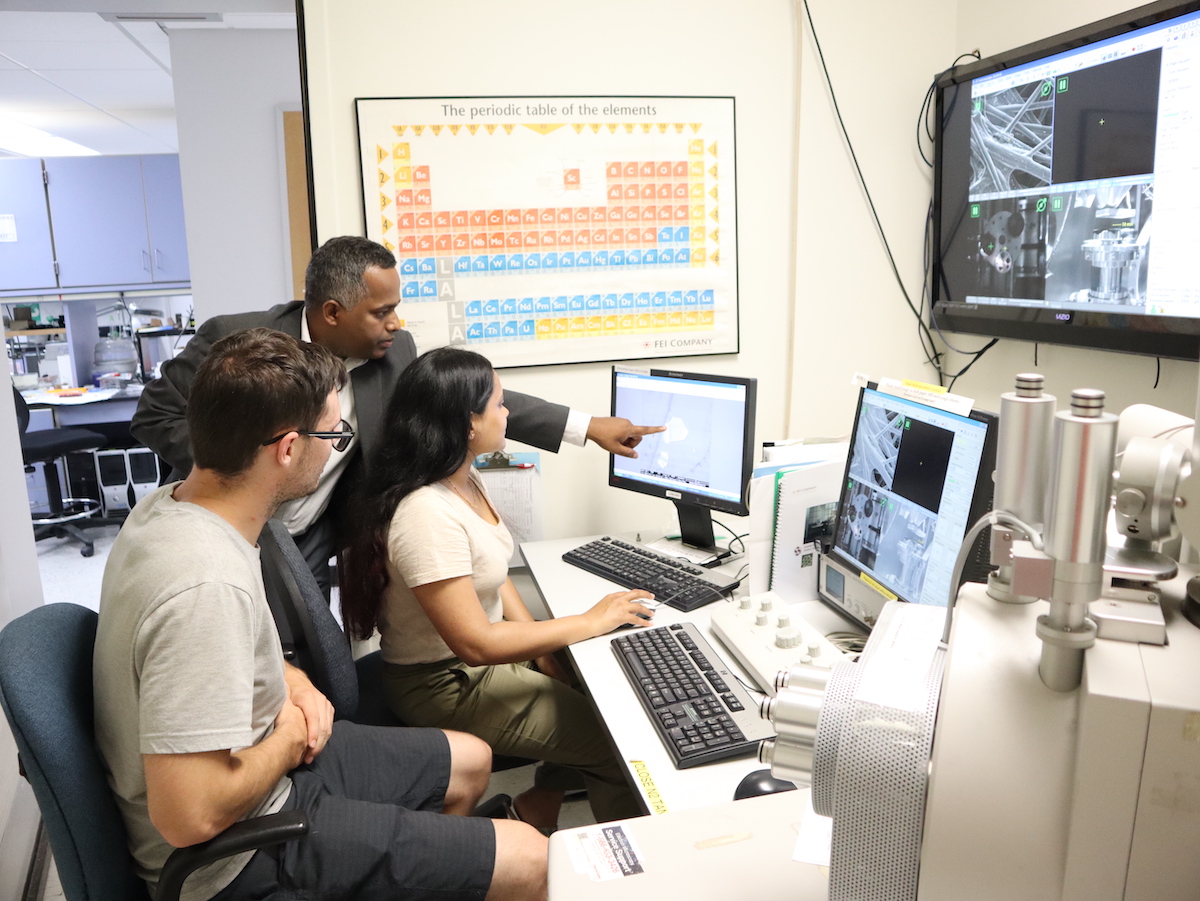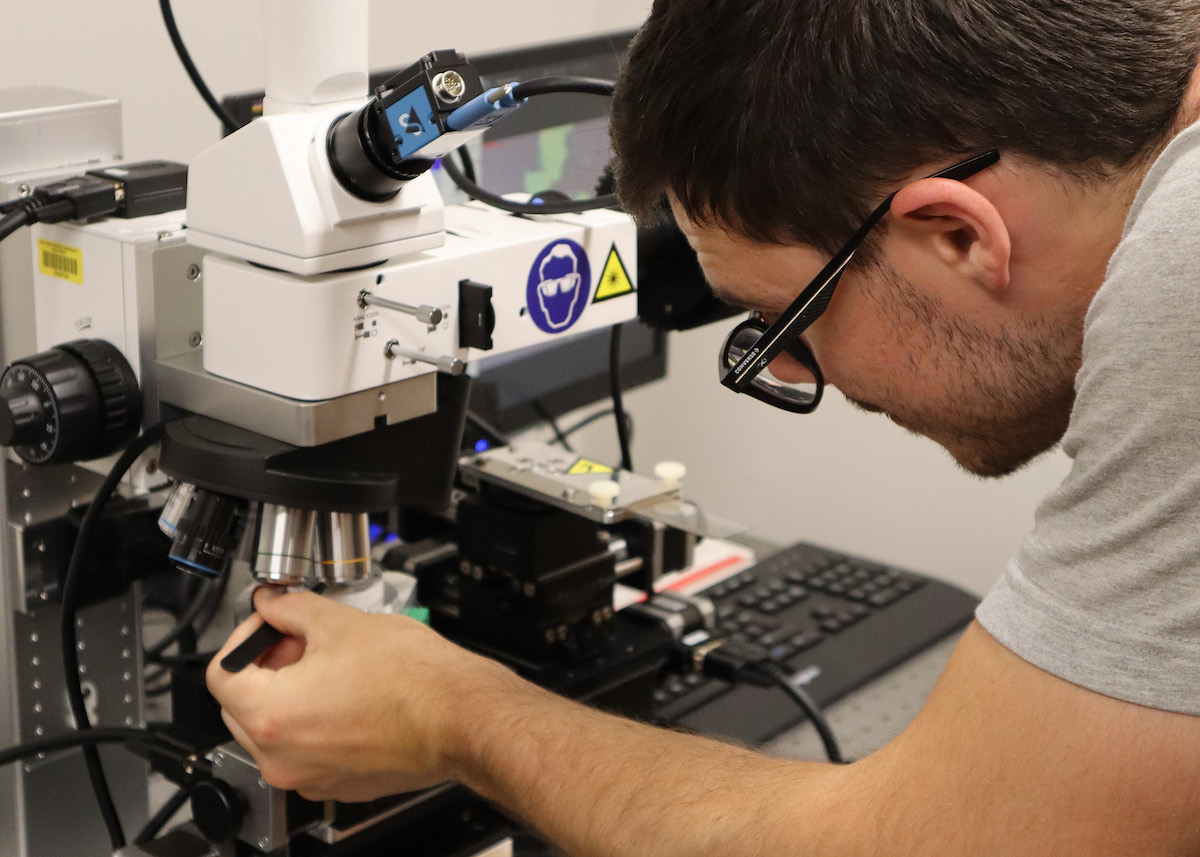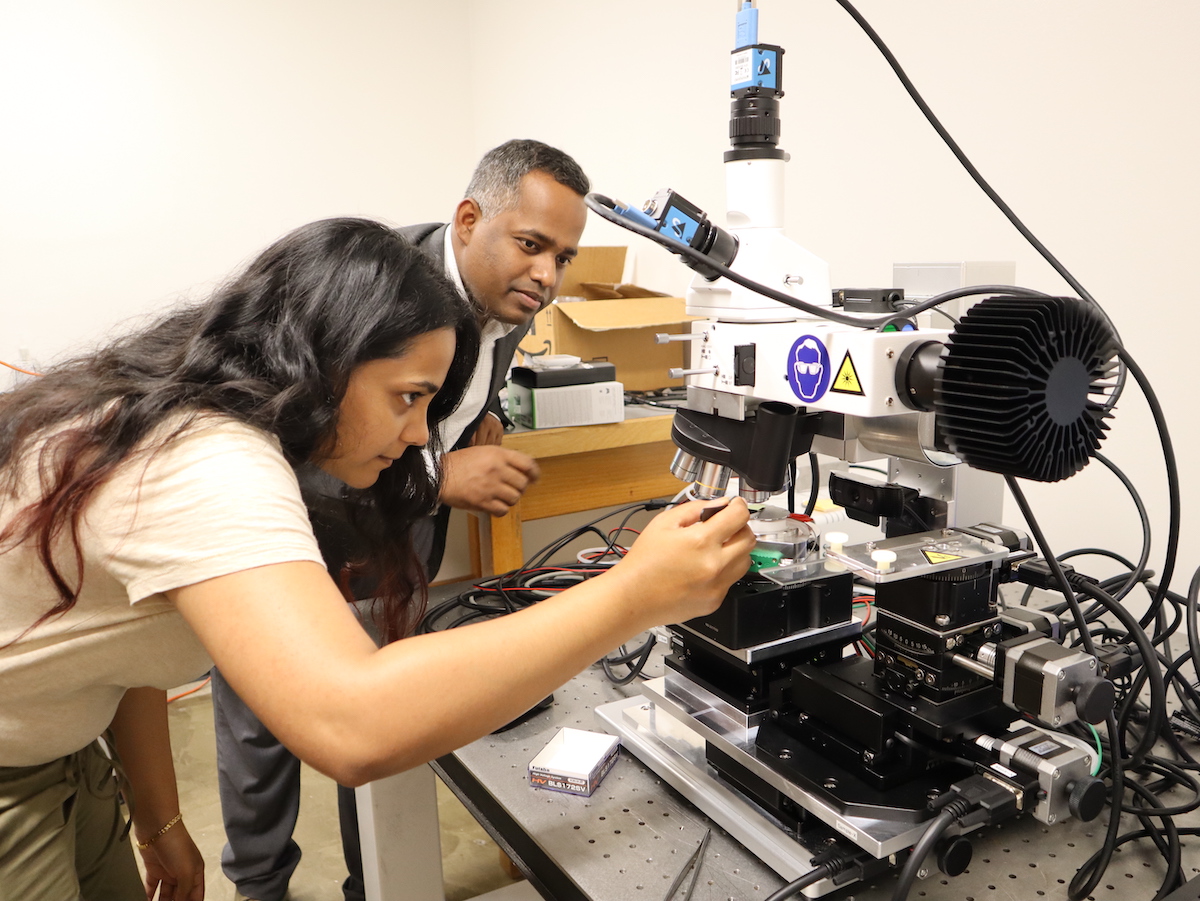SDSU physicists harness the power of quantum science to develop new materials that provide legions of benefits
By Bryana Quintana

Sanjay Behura (middle) in the Electron Microscopy Facility pointing to a crystal of two-dimensional material exposed to electron beam irradiation. (Bryana Quintana/SDSU)
From improving methods for detecting diseases to facilitating more secure data transfer and enabling speedier computers, quantum materials hold a promise to transform daily life. Quantum materials exhibit properties that can be understood using quantum mechanics, a branch of physics that helps explain the workings of the physical world at the fundamental level.
However, quantum effects occur on subatomic scales and under very cold temperatures, appearing only for short periods, which makes studying them a challenge.
Sanjay Behura, an assistant professor of physics at San Diego State University’s College of Sciences is working with students to confront this challenge and help make quantum mainstream.
“Quantum is a growing industry, especially in San Diego and California more broadly,” said Behura, who started at SDSU in Fall 2022 and is currently working under four federal research grants. “Here at SDSU, we are preparing students for the quantum workforce and hope to establish partnerships with local companies and government labs to provide further training opportunities.”
Quantum science is the study of energy and matter at the fundamental level. Physicists have unlocked methods for integrating quantum science into a range of materials, giving them capabilities far beyond those of ordinary objects.
One type of quantum material is as thin as an atom and resides in only two dimensions, formed when a single two-dimensional layer is taken from a dry and granular bulk material. This process restricts the movement of electrons in the new material, which gives rise to quantum mechanical effects including enhanced electrical conductivity and transparency.
These electrical and optical properties have enabled revolutionary products like solar cells and mechanisms that power electronics. Think of your smartphone, for example. It conducts enough electricity to allow you to safely touch the screen and open Instagram but it is also transparent enough for you to observe what is happening behind it and catch up on all your friends have been up to.
New Applications
These unique properties give quantum 2D materials a myriad of important applications in areas including computing.

Second-year Physics master’s student Nicholas Schottle is preparing a moiré quantum material in the Quantum Materials Design and Growth Lab. (Bryana Quintana/SDSU)
Quantum computers can run at incredibly high speeds because a qubit, or quantum bit, can access the digital information of 1s and 0s simultaneously instead of one at a time, as conventional computers do. As a result, in just a few hours, quantum computers can execute large, complex computational tasks that would take today’s computers thousands of years to complete.
Performing data analyses at these speeds can improve data encryption and help prevent adverse events like pandemics or market crashes.
“Because quantum computers can process large amounts of data so much faster than classical computers, they could allow us to synthesize and model existing data in order to make predictions with more accuracy and efficiency,” said Behura. “This way, we can learn from the past to better prepare for the future.”
Quantum materials can also be used in sensing technologies to enable better detection of diseases and more accurate and precise navigation systems like GPS. Additionally, they can allow for more secure communications by helping protect data transferred via phone calls, online banking or text messaging.
Quantum Leaps in New Materials

Physics professor Sanjay Behura looks on as second-year Physics master’s student Sancia Tauro investigates quantum defects in hexagonal boron nitride in the Quantum Materials Design and Growth Lab. (Bryana Quintana/SDSU)
Behura’s teams of undergraduate, master’s and doctoral researchers are currently working on several projects that contribute to the expanding field of Quantum Information Science and Technology (QIST), including:
I-Corps: Developing a Face Mask Coated with Metal Oxide Nanostructures to Reduce the Spread of COVID and other Airborne Diseases
In this project, supported by a $50,000 grant from the National Science Foundation (NSF), researchers work to develop face masks coated in quantum materials to protect against airborne diseases. Because viruses spread via water droplets, the team seeks to take advantage of the fact that certain quantum materials are hydrophobic, meaning they repel water, by using them to create a coating along the inside of the “quantum masks.”
Two-dimensional Material Integrated Quantum Photonics Technologies
SDSU recently joined Montana State University and University of Arkansas in this collaboration sponsored by MSU and NSF, which awarded a $350,000 grant. The goal of this project is to create quantum materials that can be grown at a large scale to enable quantum technologies.
Temperature-Dependent Topological Moiré Excitons in Twisted Transition Metal Dichalcogenides for Quantum Photonics
The objective of this project, sponsored by the Air Force Office of Scientific Research with a $200,000 grant and the University of Arkansas Pine Bluff, is to form 2D semiconductor heterostructures and study their optical properties. The insight gained from this project could contribute to quantum sensing applications.
Direct Growth of hBN on SiN for Waveguide Coupled Quantum Light Emission
In this project, supported by a $200,000 grant from the Air Force Research Laboratory, researchers aim to grow 2D crystals and characterize their photonic properties. The team intends to apply this knowledge to create new quantum materials for technologies including sensing and computing.
Students interested in getting involved with these projects can contact Behura at sbehura@sdsu.edu
Learn about other quantum research at SDSU and find out more about SDSU’s Physics Department.